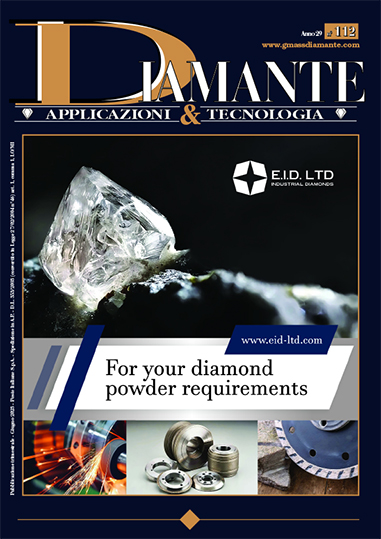|
Diamante A&T Contents Year XXIX - June 2023 |
|||||
|
Front Cover: EID LTD For more than 50 years EID has been providing the widest array of top quality industrial diamond stones, natural and synthetic diamond powders to the trade.
In the Spotlight 10) Marmomac 2023, natural stone focuses on design, furniture, luxury and contract 18) VITRUM 2023: exhibitors give thumbs up to innovations, already 8,000 m2 reserved and more than 100 businesses registered in the first month of sales 20) Preparations for the Stone+tec 2024 trade fair for natural stone are in progress - Good mood in the stonemasonry craft 24) Euro PM2023 Congress & Exhibition, road to Lisbon Diamond Tools 37) Manufacturing of graded grinding layers by B. Denkena, B. Bergmann, D. RaffaltInstitute of Production Engineering and Machine Tools (IFW), Leibniz University Hannover, Garbsen, Germany
Abstract: Grinding of end mill cutters leads to an unevenly radial wear of the grinding wheel due to varying geometric engagement
conditions along the grinding wheel width. This results in a decreasing precision of the resulting tool geometry. Previous studies showed that simulation-based
load-adjusted grinding layers reduce the uneven wear. A diamond grain concentration gradient across the grinding layer width enables load-adjustment on the operational
demands. For an effective reduction of the wear differences, an accurate and repeatable manufacturing method for smooth transitions between the concentration zones is required.
This paper shows an approach for the manufacturing of graded grinding layers by Field-Assisted-Sintering. Optical images are taken of cross-sectioned grinding layer
samples. An image analysis software was used to evaluate the grain concentration gradient. As a conclusion, the comparison of the manufactured gradients with the simulated
gradients shows that the presented manufacturing method allows repeatable fabrication of graded grinding layers. 53) Influence of microstructural assemblage of substrate on the adhesion strength of Tisin coated PcBN systems by S. Gordon1,2, E. Jiménez-Piqué1,2, T. Rodriguez-Suarez3, R. M'Saoubi4, J.J. Roa1,2, L.F.P. Franca3, L. Llanes1,21 CIEFMA - Department of Materials Science and Engineering, EEBE, Universitat Politècnica de Catalunya, Barcelona, Spain 2 Barcelona Research Center in Multiscale Science and Engineering, Universitat Politècnica de Catalunya, Barcelona, Spain 3 Element Six (UK) Ltd, Global Innovation Centre, Harwell Oxford, Didcot, Oxfordshire, United Kingdom 4 Seco Tools AB, R&D Material and Technology Development, Fagersta, Sweden
Abstract: The coating adhesion strength of two TiSiN-coated polycrystalline cubic boron nitride (PcBN) grades is studied in
this work. Microstructural assemblage of the PcBN substrate,described in terms of cBN content, binder chemical nature
and average cBN grain size, is considered as the main experimental variable. In the present investigation a conical indentation test method is implemented to assess load levels
at which cracking and delamination emerge, and their evolution with increasing load. Tests were conducted by using a conical diamond indenter of 200 ?m in radius (Rockwell C) and applying
loads ranging from 98 to 980 N. They were complemented by an extensive and detailed SEM inspection of fracture micro-mechanisms (i.e. type of cracking pattern and delamination).
Results show that emergence and evolution of damage strongly depend on the substrate microstructural assemblage: the higher the cBN-content, the more resistant to both cracking
and delamination is the coated system. 63) Determination of the influence of the mixing quality on the grinding tool bond after sintering by B. Denkena, B. Bergmann, T. GeschwindInstitute of Production Engineering and Machine Tools, Leibniz University Hanover, Germany
Abstract: The powder mixture properties determine the sintering result of vitrified bonds for grinding tools. In this paper the
influence of the mixing process on porosity of the sintered bonds through the bulk density is shown. Therefore, the bulk density of the mixture and the abrasive concentration and
sintering temperature and holding time were varied. Porosity, shrinkage and bending fracture stress were determined to evaluate the influence of these parameters
on the sintering result. It was shown that there is no significant influence of abrasive concentration, sintering time and temperature on porosity, shrinkage and bending fracture
stress. Instead it was shown, that abrasive concentration has a negative influence on the porosity of the powder mixture. With increasing the concentration from two to ten Vol% the
porosity of the powder decreases at about 1.6 Vol%. Further the shrinkage has also a negative influence on the porosity of the sintered pellets. Here, with increasing the
shrinkage about six Vol% the porosity of the sintered pellets decreases about four Vol%. These outcomes are important for designing moulds and optimizing sintering results. News and Events 72) The next meeting between market professionals will be at SAIE Bari from 19 to 21 October 2023. 76) INTERMAT 2024: a redesigned trade show model |
|||||

